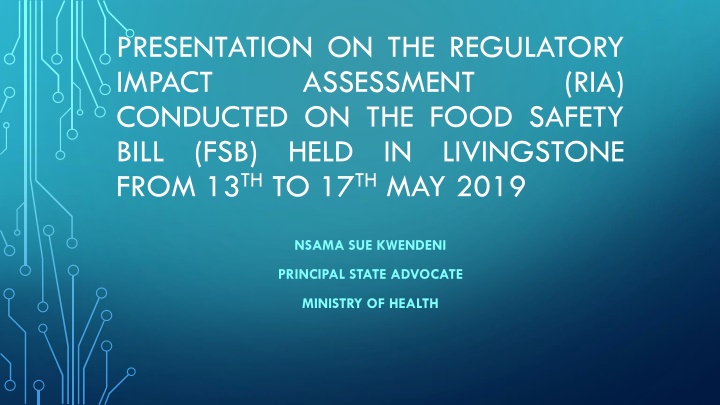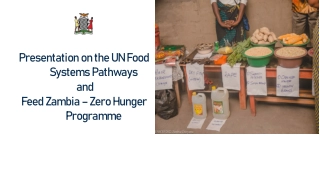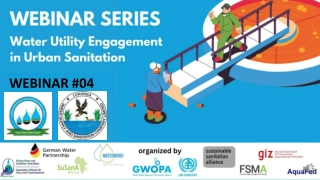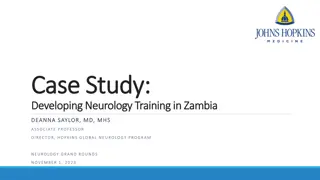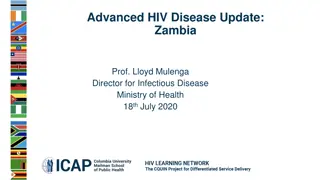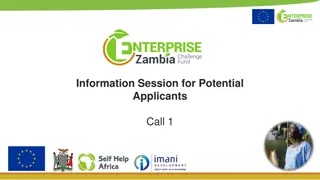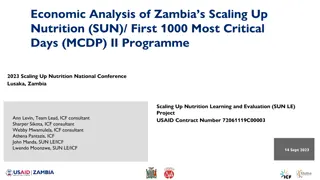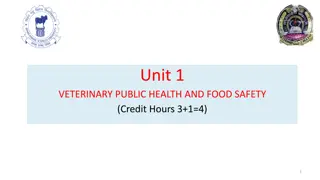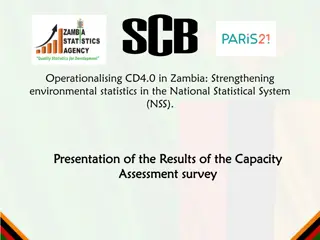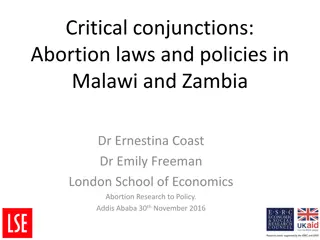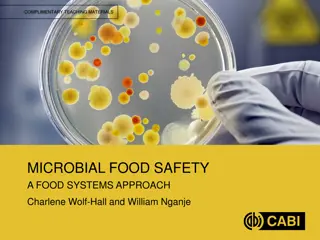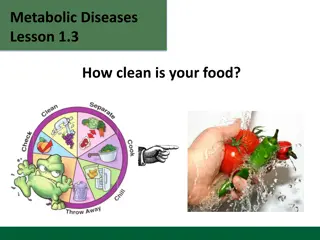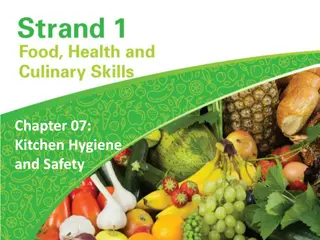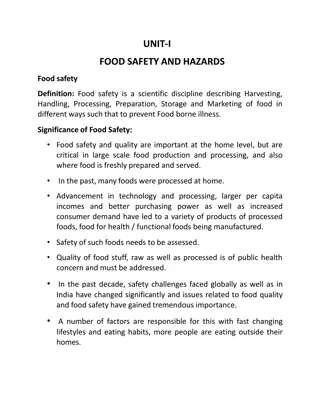Enhancing Food Safety Regulations in Zambia
This presentation discusses the Regulatory Impact Assessment conducted on the Food Safety Bill in Livingstone in May 2019, highlighting the need for clear mandates, improved coordination, and modernization of food control systems in Zambia to protect consumer health and enhance trading partnerships.
Download Presentation

Please find below an Image/Link to download the presentation.
The content on the website is provided AS IS for your information and personal use only. It may not be sold, licensed, or shared on other websites without obtaining consent from the author.If you encounter any issues during the download, it is possible that the publisher has removed the file from their server.
You are allowed to download the files provided on this website for personal or commercial use, subject to the condition that they are used lawfully. All files are the property of their respective owners.
The content on the website is provided AS IS for your information and personal use only. It may not be sold, licensed, or shared on other websites without obtaining consent from the author.
E N D
Presentation Transcript
PRESENTATION ON THE REGULATORY IMPACT ASSESSMENT CONDUCTED ON THE FOOD SAFETY BILL (FSB) HELD FROM 13THTO 17THMAY 2019 (RIA) IN LIVINGSTONE NSAMA SUE KWENDENI PRINCIPAL STATE ADVOCATE MINISTRY OF HEALTH
PURPOSE OF THE RIA IN RELATION TO FSB The role of an RIA is to provide a detailed and systematic appraisal of the potential impacts of a new regulation in order to assess whether the regulation is likely to achieve the desired objectives. The need for RIA arises from the fact that regulation commonly has numerous impacts and that these are often difficult to foresee without detailed study and consultation with affected parties. Economic approaches to the issue of regulation also emphasize the high risk that regulatory costs may exceed benefits. From this perspective, the central purpose of RIA is to ensure that regulation will be welfare-enhancing from the societal viewpoint - that is, that benefits will exceed costs. RIA comparative context, with different objective sought being analysed and the results compared. is generally means conducted of achieving in a the
PURPOSE OF THE RIA IN RELATION TO FSB The current multiple agency lack of coordination on food safety in the country has generally not provided an efficient and effective food control agency with a clear mandate and authority to prevent food safety problems. Lack of coordination has hindered the development of an effective and modern food control system that is in line with modern principles. These inadequacies impair Zambia s capabilities to protect consumer s health and create confidence in trading partners. The current revision of the Food and Drug Act and of the Public health Act provides the opportunity to address these shortcomings. It is critical to establish a more conducive legal and regulatory and institutional framework that is based in international best practices to foster synergy and harmonization of interventions along the food continuum.
PROBLEM TO BE SOLVED BY A RIA IN RELATION TO THE FSB Several needs assessments concerning the Zambian food safety control system have highlighted weakness in the system with inconsistences with regards to international best practices. Among this is the legal and regulatory framework of the control system which has been found to be characterized by abundance and fragmented legislation. The The fragmentation fragmentation of of legal legal compounded compounded by by lack lack of of clear clear delineation delineation of safety safety at at all all stages stages of of the the food food continuum continuum. . The for for the the regulation regulation of of food food safety safety in that, that, A A needs needs assessment assessment done done in identified, identified, among among others, others, that that food systems systems and and food food safety safety management management policies coordinated, coordinated, particularly particularly where where departments departments are are involved involved . . regulatory regulatory of roles The regional in SADC SADC member member states in the the SADC SADC Region food safety safety management policies are a a number number and and framework framework to ensure ensure food regional guidelines guidelines states observes Region back back in management control are weak weak and of of Government Government is is roles to food observes in 2006 2006 control and poorly poorly
PROBLEM TO BE SOLVED BY A RIA IN RELATION TO THE FSB The status of national food control systems were evaluated by FAO/WHO coordinating committee findings reviewed that there was the need to have Improved coordination of activities among the authorities in the Zambian Food safety systems. The The poor poor performance performance of of the the Zambian system, system, could could be be largely largely attributed attributed to entity entity with with both both a a legal legal mandate mandate and facilitate facilitate execution execution of of its its function function. . for Africa and the Zambian food to lack and financing financing mechanism food safety safety control lack of of a a coordinating coordinating mechanism to control to
PROBLEM TO BE SOLVED BY A RIA IN RELATION TO THE FSB Zambia has a Multiple Agency System with several ministries and other statutory bodies undertaking different functions in food safety. However, this has not worked well and resulted in lack of vision and strategic planning for the national food safety agenda, duplication of functions between ministries and other statutory functions; over-burdening of the food industries with multiple inspections and licensing. This has led to the challenges of ensuring a coordinated food safety system in the country. The multi-agency system has contributed to the current challenges as there is no one institution to be held accountable and liable on food safety matters. bodies; neglect of certain
GOALS OF THE PROPOSED INTERVENTION To strengthen food safety systems in the country and to protect the Public against health hazards and fraud in the sale and use of food and to provide for matters incidental thereto or connected there with. To To provide provide a a comprehensive comprehensive food food safety safety law food food additives additives that that are are authorized authorized to to be be used To To provide provide for for analytical analytical services services for for food food safety To To include include detailed detailed matters matters such such as, as, emerging emerging issues contaminants contaminants in in food food; ; To To ensure ensure that that the the food food meets meets consumer consumer expectations substance substance and and quality quality and and not not misleadingly misleadingly represented To To remove remove the the drugs drugs and and cosmetics cosmetics with with its Drugs Drugs Act Act that that were were taken taken to to the the Medicines Medicines and of of 2013 2013; ; law that used in safety in that regulates regulates the in foods foods; ; in the the country issues of of food the hazards hazards and and country. . food safety safety such such as as expectations in represented; ; its regulations regulations from and Allied Allied Substances in terms terms of of nature, nature, from the Substances Act the Food Food and Act No and No. .3 3
EXPERIENCE WITH COST EFFECTIVE ANALYSIS The The Cost Cost effectiveness effectiveness analysis analysis which developed developed countries countries provide provide access basis basis of of clinical clinical and and health health needs, fund fund these these services services publicly publicly. . rooted rooted in in values values of of equity equity in explained explained in in terms terms of of efficiency efficiency. . If If the the aim aim is is to to obtain obtain the the maximum life life using using the the resources resources available, available, then be be renounced renounced in in order order to to focus focus on Personal Personal preferences preferences can can always according according to to the the ability ability and and willingness which the to health health services needs, and and thus thus have This This approach, approach, in health health care, the vast vast majority majority of services on have chosen chosen to apparently apparently care, can can also of access to on the the to also be be maximum amount then extravagance extravagance has on what what is is clinically clinically effective always be be satisfied satisfied individually willingness to to pay pay for amount and and quality quality of of to has to effective. . individually for them them. .
EXPERIENCE WITH COST EFFECTIVE ANALYSIS The The following following were analysis analysis: : a. Health impacts of proper food safety systems: The The increased increased cost cost of of health diseases diseases in in the the population population is of of well well- -structured structured food food safety safety systems that that consumption consumption of of unsafe unsafe food viruses, viruses, parasites parasites or or chemical chemical substances, diseases diseases ranging ranging from from diarrhea diarrhea to Further Further to to this, this, an an estimated estimated 600 the the world world fall fall ill ill after after eating eating contaminated every every year, year, resulting resulting in in the These These have have a a significant significant impact economy economy of of the the country country. . were the the major major findings findings from from the the cost cost effective effective health care is preventable preventable through systems. . Added food containing substances, causes to cancers cancers 600 million million almost contaminated food the loss loss of of 33 33 million impact on on the the health care for for food food- -borne through the Added to containing harmful causes more borne illnesses illnesses and the establishment establishment to this, this, WHO WHO reports harmful bacteria, more than and reports bacteria, than 200 200 almost 1 1 in food and million healthy health on on the in 10 and 420 healthy life the population population and 10 people people in 420 000 000 die life years in die years. . and
EXPERIENCE WITH COST EFFECTIVE ANALYSIS Advocating for food safety is an important component of health security and for integrating food safety into national policies and programs in line with the International Health Regulations (IHR - 2005) Access to sufficient amounts of safe and nutritious food is key to sustaining life and promoting good health. This is achieved through the implementation of a well organised food safety system. Hence this cost effective analysis was the best route to follow in relation to this proposed legislation.
EXPERIENCE WITH COST EFFECTIVE ANALYSIS Social and economic impacts Safe Safe food food supplies supplies support support national national economies, contributes contributes to to food food and and nutrition nutrition security, development development Sustainable Sustainable income income from be be responsible responsible for for inspections inspections and generate generate some some income income for for the the operations Missed Missed opportunity opportunity to to build build capacity capacity to exports) exports) the the cost cost of of funding funding individual individual institutions safety safety as as compared compared to to funding funding one The The cost cost of of undertaking undertaking surveillance surveillance activities activities and and communication communication is is invariably invariably reduced reduced as to to one one institution institution which which ensures ensures maximization economies, trade security, and and underpins from within within the and issuance issuance of operations of of the to facilitate facilitate trade trade and underpins sustainable sustainable the agency agency as of permits permits which which shall the agency agency trade (import and tourism, tourism, as it it shall shall shall (import and and institutions with one single single coordinating coordinating agency risk risk assessment assessment epidemiological epidemiological as all all resources resources are maximization of with a a mandate mandate on on food food agency activities, activities, networks networks support support and and channeled resources. . risk risk are channeled the resources of the
EXPERIENCE WITH COST EFFECTIVE ANALYSIS Food Food supply collaboration collaboration between helps helps ensure ensure food Involves Involves comparisons comparisons of where where the the benefits used used in in health, health, safety, fewer fewer deaths deaths or supply chains chains now between governments, governments, producers food safety safety. . now cross cross multiple multiple national producers and national borders and consumers borders. . Good consumers Good of the the cost cannot expressed expressed in safety, education education where or better better education education system cost of of different different regulatory in monetary monetary terms where impact impact maybe system. . regulatory options, terms. . Mainly maybe expressed expressed as options, Mainly benefits cannot as
EXPERIENCE WITH CONSULTATIONS The importance cannot be overstated these are some of benefits Firstly, the WE DID IT FEELING - decision informed informed and in tune with those who the actions will affect. Secondly, the I WAS A PART be greater greater satisfaction satisfaction from from Through the engagement process, those who decisions will affect will feel they have inputted into the final outcome and everyone s views have been taken into account. Depending on the method of consultation, they perspective may not be shared by all and that there is a need for compromise. the decision making making will will be be more more OF THAT FEELING with with there outcome outcome. will stakeholders stakeholders the the that will also understand that their
EXPERIENCE WITH CONSULTATIONS This establishes the legitimacy of the regulation by allowing people to raise concerns and participate in the regulatory process before regulation is implemented. Kept the Ministry of Health's ear to the ground. There are times in which stakeholders are focused on their own interests. This is common but not exclusive to external stakeholders. All hail the Blockers of progress!!! This is also frequently found when external stakeholders fear that a business' actions will harm their interests. Active consultations had had participation participation from ( (5 5) ) consultative consultative meetings meetings were were conducted conducted with institutions institutions. . These These included included - - from at at various various meetings with stakeholders stakeholders from meetings. . A A total total of from various various of Five Five
EXPERIENCE WITH CONSULTATIONS i. Ministry of Health ii. Ministry of Agriculture iii. Ministry of Livestock and Fisheries iv. Ministry of Commerce and Industry v. Ministry of Local Government vi. Ministry of Justice vii. Veterinary Association of Zambia viii. University of Zambia (School of Vet)
EXPERIENCE WITH CONSULTATIONS ix. University of Zambia (School of public health) x. Department of Veterinary Services xi. Food and Drugs Control Laboratory xii. Zambia Bureau of standards xiii. Zambia Institute of Environmental Health xiv. National Biosafety Authority xv. NISIR (National Institute for Science and Industrial Research) xvi. Lusaka City Council xvii. Zambia Compulsory Standards Xviii. Business Regulatory Review Agency
EXPERIENCE WITH CONSULTATIONS This implementation of the initiative. Stakeholders will feel ownership of the venture, and are therefore more likely to want the venture to succeed. Finally, consulting with people development is an example of best practice. governance and transparency, demonstrates a desire to engage in meaningful two-way communication, and recognises the important contribution stakeholders at all levels can make to future changes which will directly or indirectly affect them. in turn will lead to a greater chance of a successful who will be It represents good affected by a
CHALLENGES ENCOUNTERED DURING THE RIA The lateness the realization that the RIA is necessary. probably more so from the fact that we only engaged BRRA after the process had already progressed immensely. What is this monster called BRRA???Ignorance of the Act and the process. Other than that the process went on smoothly and the objects of the RIA where fulfilled. This was
WORDS OF INSPIRATION Knowledge is power? No. Knowledge on its own is nothing, but the application of useful knowledge, now that is powerful. Rob Liano (Life Coach and motivational speaker)
THE END THANK YOU FOR LISTENING.
